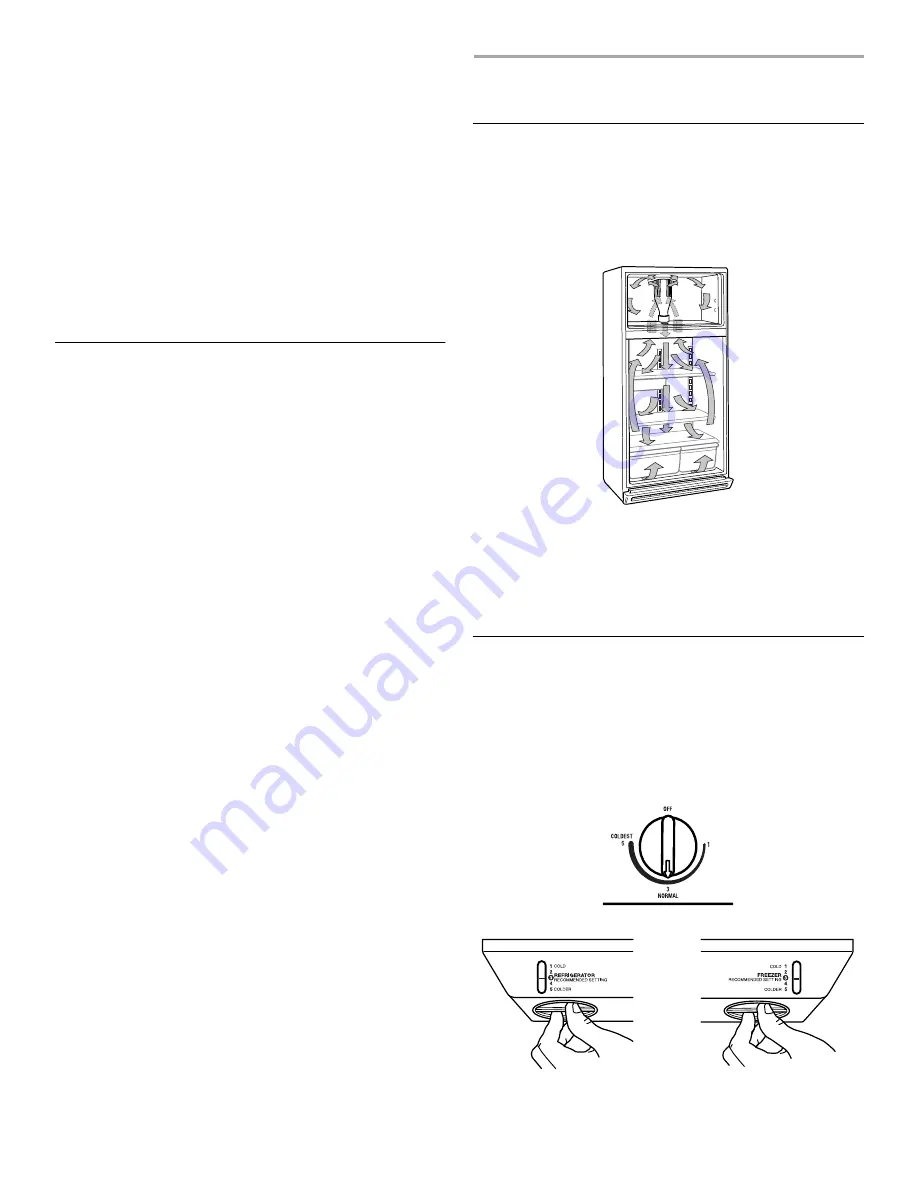
12
5.
Turn on the ice maker by opening the freezer door and
lowering the wire shutoff arm as shown.
Please refer to the
“Ice Maker” section for further instructions on the operation
of your ice maker.
■
Allow 24 hours to produce the first batch of ice.
■
Discard the first three batches of ice produced.
■
Depending on your model, you may want to select the
maximum ice feature to increase the production of ice.
NOTE:
The ice maker and water dispenser feature of this new
refrigerator may make sounds that your old refrigerator didn’t
make. The following describes some of the normal sounds and
what may be making them:
■
You may hear a buzzing sound when the water valve
opens to flow water to the dispenser or to fill the ice
maker for each cycle.
■
Rattling noises may come from the water line immediately
after dispensing water.
Normal Sounds
Your new refrigerator may make sounds that your old one didn’t
make. Because the sounds are new to you, you might be
concerned about them. Most of the new sounds are normal. Hard
surfaces, such as the floor, walls, and cabinets, can make the
sounds seem louder. The following describes the kinds of sounds
and what may be making them.
■
If
your product is equipped with an ice maker, you will hear a
buzzing sound when the water valve opens to fill the ice
maker for each cycle.
■
Your refrigerator is designed to run more efficiently to keep
your food items at the desired temperatures and to minimize
energy usage. The high efficiency compressor and fans may
cause your refrigerator to run longer than your old one. You
may also hear a pulsating or high-pitched sound from the
compressor or fans adjusting to optimize performance.
■
You may hear the evaporator fan motor circulating air through
the refrigerator and freezer compartments. The fan speed
may increase as you open the doors or add warm food.
■
Rattling noises may come from the flow of refrigerant, the
water line, or items stored on top of the refrigerator.
■
Water dripping on the defrost heater during a defrost cycle
may cause a sizzling sound.
■
As each cycle ends, you may hear a gurgling sound due to
the refrigerant flowing in your refrigerator.
■
Contraction and expansion of the inside walls may cause a
popping noise.
■
You may hear air being forced over the condenser by the
condenser fan.
■
You may hear water running into the drain pan during the
defrost cycle.
REFRIGERATOR USE
Ensuring Proper Air Circulation
In order to ensure proper temperatures, you need to permit
airflow between the refrigerator and freezer sections. As shown in
the illustration, cool air enters through the bottom of the freezer
section and moves up. Most of the air then flows through the
freezer section vents and recirculates under the freezer floor. The
rest of the air enters the refrigerator section through the top vent.
Do not block any of these vents with food packages. If the vents
are blocked, airflow will be prevented and temperature and
moisture problems may occur.
IMPORTANT:
Because air circulates between both sections, any
odors formed in one section will transfer to the other. You must
thoroughly clean both sections to eliminate odors. To prevent
odor transfer and drying out of food, wrap or cover foods tightly.
Using the Control(s)
For your convenience, your refrigerator control(s) are preset at the
factory. When you first install your refrigerator, make sure that the
control(s) are still preset to the mid-settings as shown.
NOTE:
To turn your refrigerator off, turn the refrigerator control to
the word OFF or until the word OFF appears. Your product will
not cool when the refrigerator control is set to OFF.
Mid-setting “3”
Mid-setting “3”













































